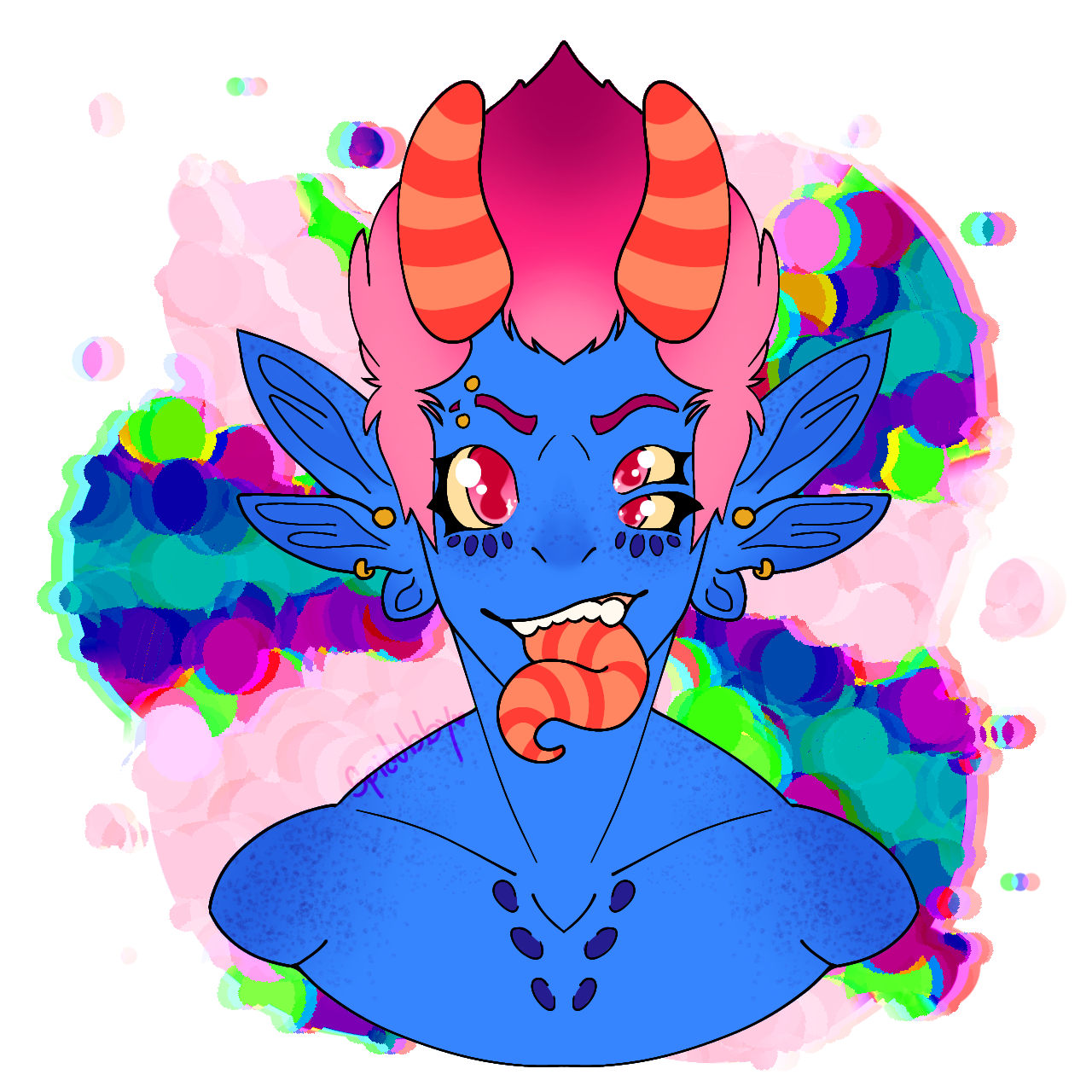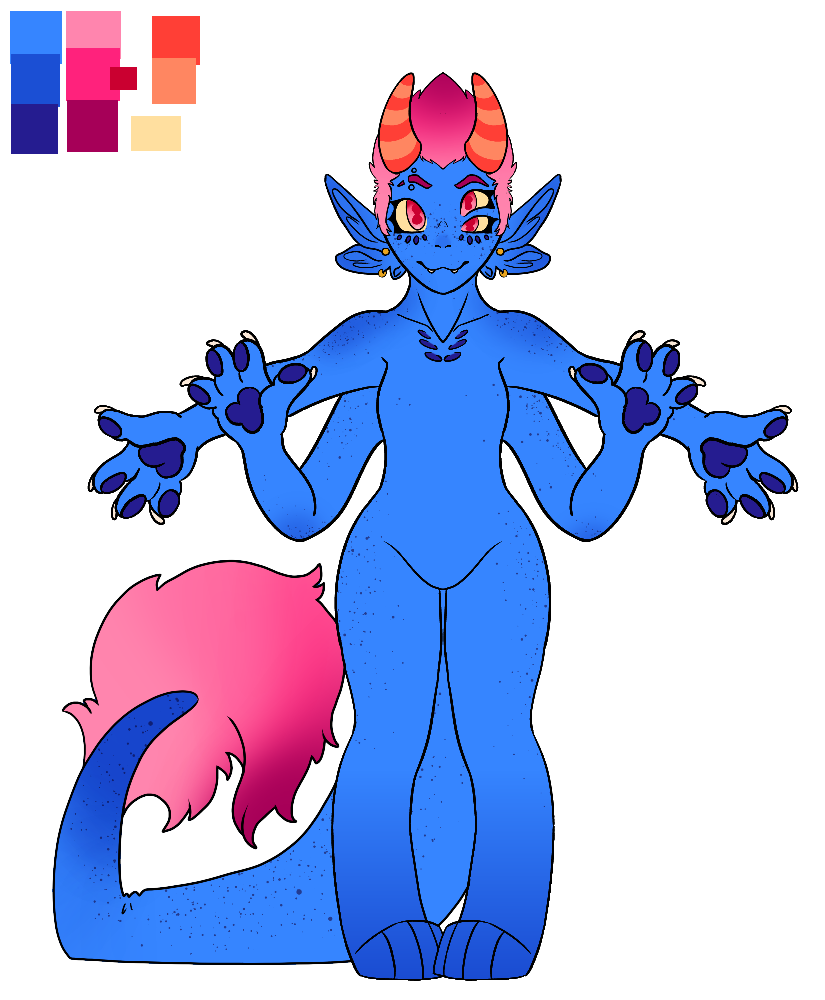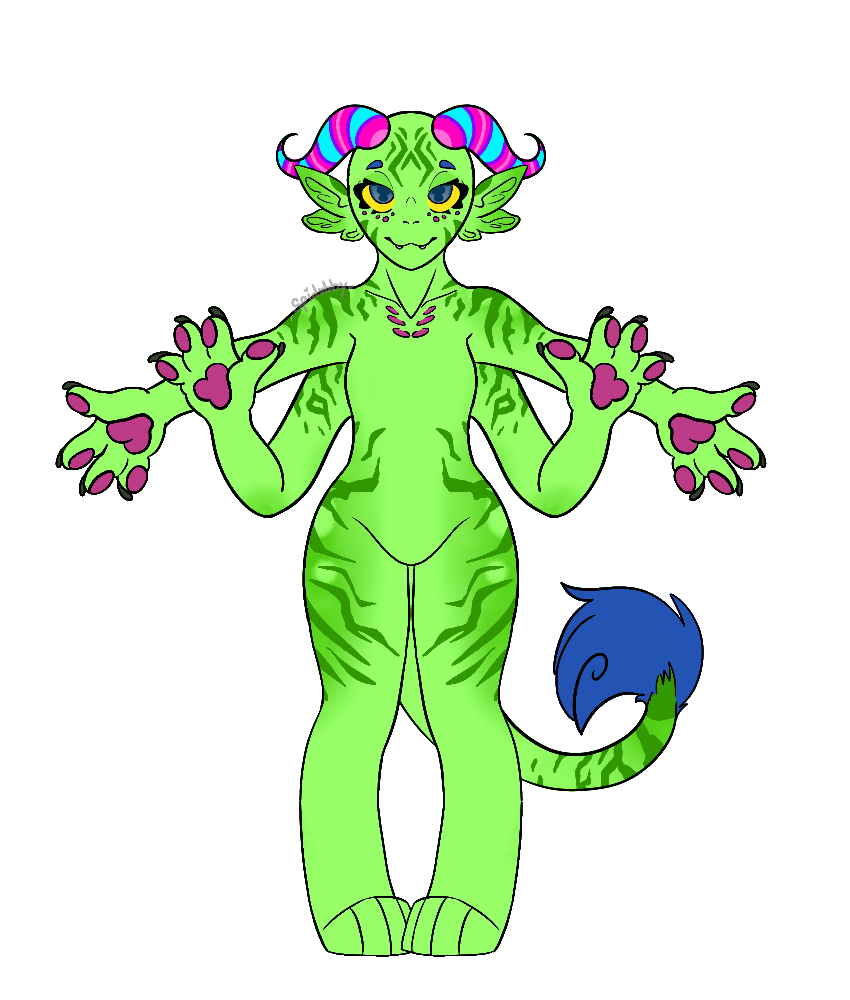AffTaff species info
Eggdis
- Created
- 6 months, 4 days ago
- Creator
- TenDaysTilSunday
- Favorites
- 0
Profile

AffTaff
GENERAL
-
SCIENTIFIC NAME: Afficus Taffidelus
-
OTHER NAMES: Affis, Taffies
-
LIFESPAN: 75-100 years
-
CLASSIFICATION: Space Faring Humanoid
-
BEST SUITED FOR: tropical habitats, plant rich environments
-
DIET: omnivore / hypocarnivore
-
HOMEWORLD: Pasuna (Inhabitable)
-
OTHER WORLDS: Unknown
Affis are a sentient species of humanoid hailing from the planet Pasuna. They are primarily tropical forest dwellers, but like humans can adapt to most climates and environments if need be. Their language is as complex as any language on earth, sounding almost sing-song-esque when spoken.
Affis were at one point considered the apex species on their planet, if only for their quick evolution to use and create technology. Early on in their development they decimated a small part of their planet in their thirst for progress. thankfully though they realized the error of their ways and quickly developed to sustain the planet while they continued to invent and create. To continue expanding their knowledge, they learned to become a space Faring race.
The Affis are a kind species, trading in exotic fruits, plants, and technology for other resources. They travel on large colony ships, built to sustain large collections of life, both fauna and flora. Violence is always a last resort for the affis, preferring to use their words over fighting. Honesty is a prime for affis when speaking to anyone, as they believe that being dishonest to the folks they are trading with is in very bad taste. However, they can be quite suspicious of species, noted by consistent eye contact with one set of their eyes.
Pasuna, the AffTaff home planet, was full of plant and animal life and many types of habitats. Their cities were large and sprawling, but well integrated with their environments. This meant from a satellite view it was very hard to know where cities were, unless you were a native. On the surface, they were easy to find, many well trodden paths leading in and out of civilization… until a plague wiped out virtually surface dwellers.
AffTaffs were created by TenDaysTilSunday.
APPEARANCE/ AT A GLANCE

AffTaffs are a brightly colored bipedal race with 4 arms, two digitigrade legs, horns, and tails. An Affi can have between 2-5 eyes, the average being 4.
An AffTaff's vision exceptional, but only because of the incredibly sensitive heat pits that are under their eyes and on their chest. These heat pits act in the same way a snake's do! it's primarily used in hard to see areas, as affis do not have low light/dark vision.
An Affi has exceptional hearing, as they have three sets on their head! Each set hears in slightly different tones, allowing a wide range of octaves to be heard by this species. This does however mean that they are sensitive to loud noises and environments.
An affi's Horns are used for display and defense. before civilization, they would show off these Horns as a warning to their opponent while holding out their arms and thrashing their tails to appear bigger and more intimidating. some more aggressive males would even use them to fight, by grappling and then furiously head-butting their aggressors.
Their heads are very tough as a result, and gentle head conks with their own head are considered affectionate.
Horns are still useful to an Affi, if only for attraction purposes. they are sensitive, and taken care of as a result. many are sensitive enough to predict weather patterns or even changes in atmospheric pressure. (kind of like when bones ache before a storm)
The horn color matches the inside of an Affi's mouth!
At one point before an environment could be controlled, tails were very useful to an affi! Some would help protect against the weather, or provide an extra limb to carry or climb. They are very expressive with their tails, kind of like a dog or cat. in the past they were also used as mating displays! Today, tails are still attractive to an affi, and are more meant for style than use as they were previously. However, a tailless Affi is not considered outcast or disabled by society.
 The Primary color of an AffTaff on their home planet would most commonly denote their heritage and what environment they are best suited for, for example: A blue Affi is most likely to live in cold climates, whereas a yellow Affi would prefer a warmer climate like a savanna. Green is the most common color, as they are the most adaptable to an environment.
The Primary color of an AffTaff on their home planet would most commonly denote their heritage and what environment they are best suited for, for example: A blue Affi is most likely to live in cold climates, whereas a yellow Affi would prefer a warmer climate like a savanna. Green is the most common color, as they are the most adaptable to an environment.
Green affis were the first and most common space scout as a result. There were more green affis out in space than any other color when Pasuna was quarantined.
Due to their space Faring lives now, the color denotion is not entirely true anymore. There are ships who's primary populace may have a dominant color and environmental heritage, which leads to said ships having an environment best suited for the Affis. This is uncommon however, as most colony ships carry wide spectrums of Affis; individual living quarters are customized to match their environmental heritage.
Affis are oviparous, and generally produce 1-2 eggs per clutch. During the first stage of the pregnancy, an affi mother will carry the eggs for 3 months before laying them. Affi Eggs start off a very pale color of the child's base color (commonly one of the parents colors, or even a mix.). Once laid, it takes 9 months for the child to hatch. During the 9 months a young affi develops in their egg, their egg will slowly saturate with color in flecks and patches on the shell's surface. An affi will hatch once the color is done saturating the patches.
One parent will ALWAYS tend to the clutch, no matter what. During this time, affis have a tendency to be a little overprotective and aggressive when others aside from the parents or very close relatives/friends are close to the clutch due to stress. The couple are constantly monitoring the eggs, providing a soft and warm nest for their progeny.
Once hatched, baby affis, called whelps or whelplings, quickly learn to crawl. They already have teensy little milk teeth and nubbins on the head. When a young whelp begins its life, many times they will have one pair of arms consistently folded against themselves, as that was how they were laid in the egg. Parents will train their child to use their secondary set. Later on in life, this habit can still be seen in adults, as in times of distress, an affi will fold their arms close to their bodies subconsciously. It can also be witnessed during sleep.
Aliquam eget pellentesque massa, sit amet auctor ipsum. Vestibulum ante ipsum primis in faucibus orci luctus et ultrices posuere cubilia curae; Pellentesque congue pulvinar libero id porta. Nunc mauris mi, tincidunt vitae sollicitudin porta, ornare ut urna. Quisque tincidunt massa orci, eu eleifend mi iaculis quis. Proin egestas odio quis sem iaculis molestie. Suspendisse ac nunc iaculis elit hendrerit scelerisque.
It was sudden, brought to the surface from a sick escape pod from an unknown species that crashed on Pasuna. Debris landing on the planet's surface was common, as they lived near an asteroid belt.. so for the scavengers it was a normal day when they opened that pod and skimmed the inside for anything valuable. The only sign inside that the pod was inhabited was a pustule covered corpse.. Whoever scavenged it did take notes and recording of the corpse, but thought it was just some weird creature that died of starvation out in the cosmos.
It spread quickly, starting with mild allergy-like symptoms. Then quickly the carrier began to lose other sensations: taste, touch, and smell. The affected areas were slightly swollen and warm to the touch. When these symptoms surfaced, the populace began to notice. By this time though, it was too late. The third stage was setting into the earliest carriers, and is the most fatal.
In a last ditch effort to save the species, Pasuna quickly quarantined itself, sending sterilized samples of all recorded fauna DNA and Flora samples from the planet's surface to the healthy affis in space. All Affis on the surface were considered a lost cause, and deemed not safe enough to rescue by the monarchs. The population upon announcement was torn deeply on the matter. It is still a subject in deep debate to this day. Since the abandonment of their planet. The AffTaff Species has been wandering the cosmos, doing whatever they can within reason to keep their species going. Drones have been sent to sterilize the planet, with little to no luck in 200 years. Survey teams have been sent to see the state of the planet's surface, but any life that is still on the planet's surface is still infected, even if asymptomatic.
Whatever remains of the affis on the surface of pasuna have almost gone extinct, but some small populations still exist on the surface in safe zones. They were built by the ones who were left behind long ago. The surface dwellers hold a deep seeded hatred for their space faring brethren, still enraged at their abandonment by the monarchs. Little contact is accepted between land and space as a result. Drones are the only welcome contact.
Recent Images
No images.